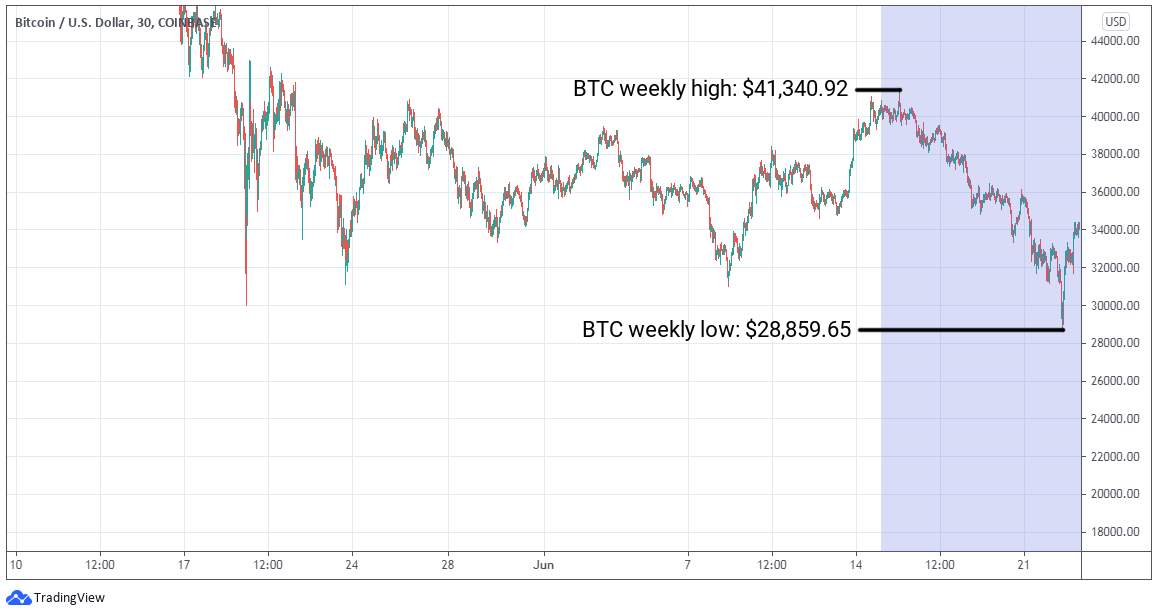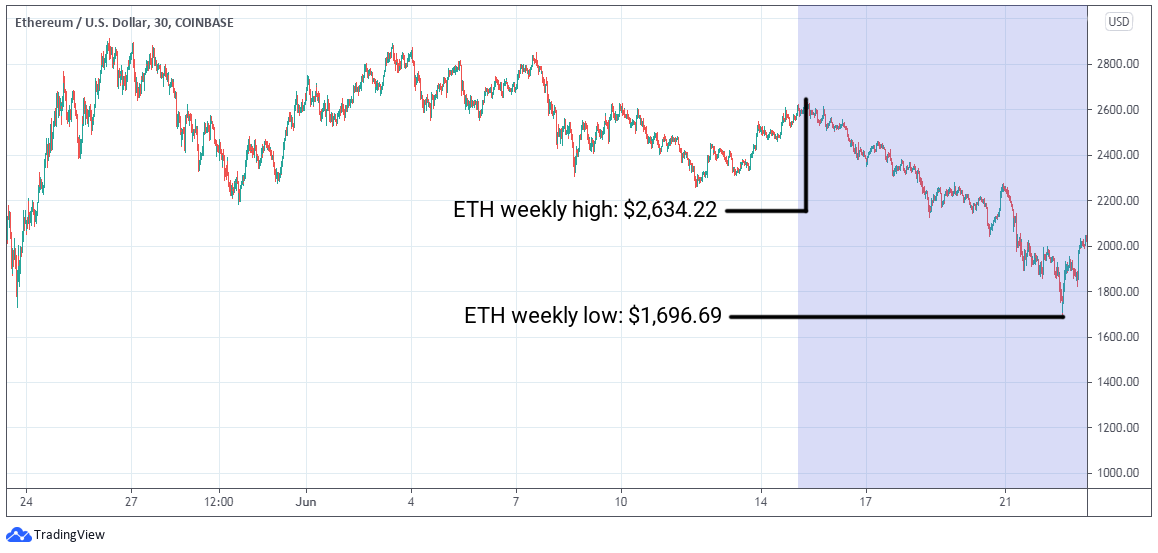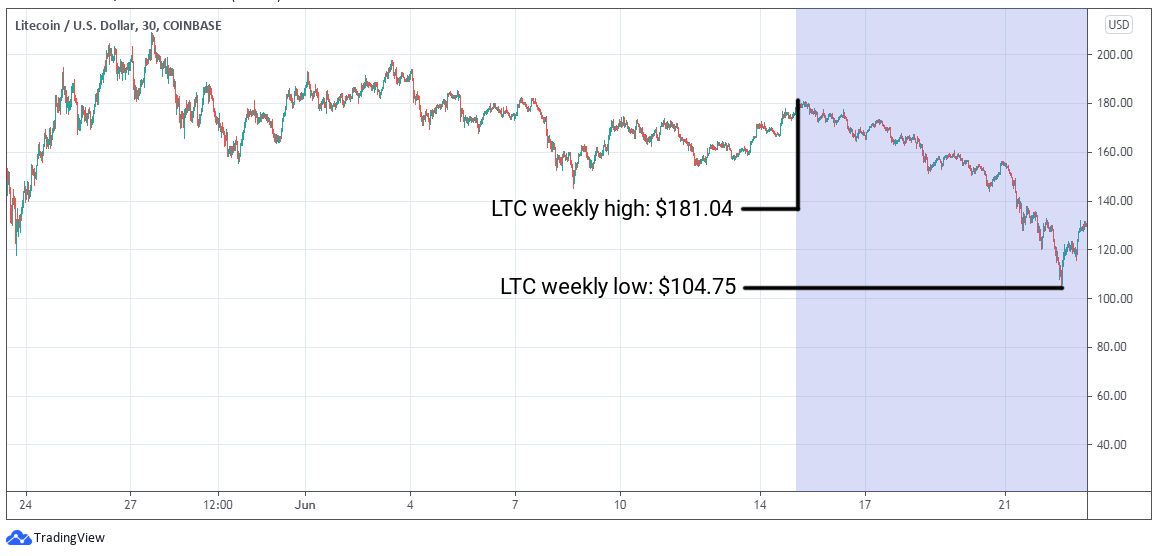ETC Group Crypto Minutes Week #25
The de-Chinafication of Bitcoin: Cryptomining migration begins
The de-Chinafication of Bitcoin: Cryptomining migration begins

China’s continuing crypto crackdown commanded most of the newsflow throughout the week and dictated the markets. It’s the only story really worth considering in this week’s Crypto Minutes, for its wide-reaching ramifications.
In May China’s political cabinet ignited a campaign to crack down on mining and cryptocurrency trading, ostensibly to control risks to its population. The People’s Bank of China, the country’s de-facto central bank, said this week it had called upon big banks and payment processors, including Alibaba (NYSE:BABA) subsidiary Alipay, and state-owned lenders like the Agricultural Bank of China, the Postal Savings Bank of China and the Industrial and Commercial Bank of China.
Speculative trading in virtual currencies roils economic and financial order, spawns the risks of criminal activities such as illegal asset transfers and money laundering, and endangers people’s wealth. People’s Bank of China, 21 June
China cannot control Bitcoin. And that is perhaps why the notoriously authoritarian state is redoubling efforts to extricate itself from its crypto dominance. China has the perfect surveillance technology coming in the form of the e-CNY, the country’s Central Bank Digital Currency. All of its citizen’s purchases tracked, everywhere they go.
As of April 2020, an approximate 65% of Bitcoin hashrate — the computing power used to generate new bitcoins, confirm transactions and secure the network — was concentrated in China.
Those numbers are shifting daily as Bitcoin miners now flee China in ever increasing numbers.
All signals seem to be indicating the greatest shakeup in the geographic makeup of bitcoin mining since the start of the industrial mining era. Nic Carter, CoinMetrics co-founder, 22 June
BIT Mining (NYSE:BTCM) has delivered its first batch of 320 mining machines to Kazakhstan, Coindesk reports, with plans to move two more tranches totalling 2,600 machines by July. The company’s Sichuan operations were effectively shut down on 19 June when it received notice that the state energy regulator would cut off its electricity supply. Guangzhou’s Fengua International also told CNBC on 21 June it was airlifting 3,000kg of mining machines to Maryland.
Authorities in the southwestern Chinese province ordered a halt to crypto mining, according to a report from the Communist Party-backed newspaper Global Times. More than 90% of China’s bitcoin mining capacity is estimated to be shut down, the paper said.
One of the more interesting points to come out of this is how malleable the Bitcoin mining network is. What other industry could simply break down its operations and move them across the world in a matter of days?
Could Google’s parent company Alphabet (NASDAQ:GOOGL) pick up its server farms and deposit them in a more energy efficient place overnight? Unlikely.
As CNBC reports , Texas could be one of the biggest winners from the great cryptomining migration.
Texas often has some of the world’s lowest energy prices, and its share of renewables is growing over time, with 20% of its power coming from wind as of 2019. It has a deregulated power grid that lets customers choose between power providers, and crucially, its political leaders are very pro-crypto – dream conditions for a miner looking for a kind welcome and cheap energy sources. MacKenzie Sigalos, CNBC, 15 June
Bitcoin mining pools located outside of China — like Foundry USA — are expected to be among the biggest winners of China’s policy shift.
So while in the near-term, crypto markets are taking this unprecedented uncertainty rather badly, it does mean a reconfiguration of crypto power back into the hands of the West.
A more transparent future for Bitcoin and cryptoasset markets beckons. And the ability to say definitively that cryptomining is being undertaken with more renewable energy? Surely that will be a positive for those who can look beyond the immediate market drop.
BTC/USD
Throughout the week Bitcoin prices dropped back to where they were in late January, sliding 30.1% from a high above $41,000 under $29,000. By Tuesday, BTC was struggling to hold on to $30,000 with a significant area of support in the $29,000 region. But as soon as pundits were calling a bear market, Bitcoin rallied 18% back up into the $34,000 region, with resilience the watchword of the week.

ETH/USD
Ether too was roiled by retail uncertainty, with Ethereum’s base currency falling well below the $2,000-mark it first captured in February 2021. The fundamentals of ETH continue to impress, with DeFi total value locked still rising, but spot prices showed weakness throughout out the week, shedding 35% from a high of $2,634.22 to to hit $1696.69, a two- month low. By Wednesday morning it had rebounded 20.4% with lower values below $2,000 clearly rejected.

LTC/USD
The start of the week at $181.04 was the best it got for Litecoin, as the popular payments protocol suffered a 42.1% capitulation from its peak to its zenith. Those intraday lows were numbers not seen since the bull run of late December 2020, piquing interest in the potential for a Litecoin bear market. There were brighter signs for LTC against the dollar, though, as it bounced back 25.7% to end the week at $131.77.

WICHTIGER HINWEIS:
Dieser Artikel stellt weder eine Anlageberatung dar, noch bildet er ein Angebot oder eine Aufforderung zum Kauf von Finanzprodukten. Dieser Artikel dient ausschließlich zu allgemeinen Informationszwecken, und es erfolgt weder ausdrücklich noch implizit eine Zusicherung oder Garantie bezüglich der Fairness, Genauigkeit, Vollständigkeit oder Richtigkeit dieses Artikels oder der darin enthaltenen Meinungen. Es wird davon abgeraten, Vertrauen in die Fairness, Genauigkeit, Vollständigkeit oder Richtigkeit dieses Artikels oder der darin enthaltenen Meinungen zu setzen. Beachten Sie bitte, dass es sich bei diesem Artikel weder um eine Anlageberatung handelt noch um ein Angebot oder eine Aufforderung zum Erwerb von Finanzprodukten oder Kryptowerten.
VOR EINER ANLAGE IN KRYPTO ETP SOLLTEN POTENZIELLE ANLEGER FOLGENDES BEACHTEN:
Potenzielle Anleger sollten eine unabhängige Beratung in Anspruch nehmen und die im Basisprospekt und in den endgültigen Bedingungen für die ETPs enthaltenen relevanten Informationen, insbesondere die darin genannten Risikofaktoren, berücksichtigen. Das investierte Kapital ist risikobehaftet und Verluste bis zur Höhe des investierten Betrags sind möglich. Das Produkt unterliegt einem inhärenten Gegenparteirisiko in Bezug auf den Emittenten der ETPs und kann Verluste bis hin zum Totalverlust erleiden, wenn der Emittent seinen vertraglichen Verpflichtungen nicht nachkommt. Die rechtliche Struktur von ETPs entspricht der einer Schuldverschreibung. ETPs werden wie andere Wer
ETC Group bietet erstklassige Produkte für das Investment in digitale Werte wie Kryptowährungen - und das mit Domizil Deutschland. Mit unseren physisch hinterlegten Krypto-ETPs schlagen wir eine Brücke vom klassischen, regulierten Kapitalmarkt in die lebendige Kryptoszene. Unsere ETPs sind der Schlüssel zum Ökosystem der digitalen Vermögenswerte und vereinfachen den Investmentzugang zu Bitcoin, Ethereum und weiteren Kryptowährungen erheblich.
Die ETC Group setzt sich aus einem außergewöhnlichen Team von Finanzdienstleistungsexperten und Unternehmern zusammen, die über Erfahrung mit digitalen Vermögenswerten und regulierten Märkten verfügen. Da Produktqualität und -sicherheit im Mittelpunkt unseres Produktentwicklungsansatzes stehen, ist das Unternehmen bestrebt, kontinuierlich erstklassige börsengehandelte Produkte für institutionelle Kunden auf den Markt zu bringen.
Als Unternehmen hat die ETC Group bereits BTCE auf den Markt gebracht - das weltweit erste börsengehandelte Bitcoin-Produkt mit zentralem Clearing an der Deutschen Börse XETRA, dem größten ETF-Handelsplatz in Europa sowie DA20. Dabei handelt es sich um das weltweit erste Krypto-ETP, das einen MSCI-Index abbildet und einen Schritt in Richtung Investment-Management-Produkte darstellt. DA20 ermöglicht Anlegern ein breites Marktengagement, indem es einen Index von 20 Kryptowährungen abbildet, die etwa 85 % der Kapitalisierung des gesamten Kryptomarktes abdecken.